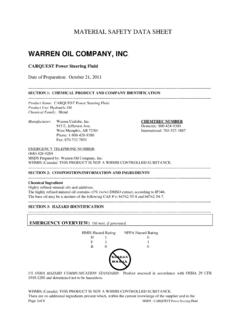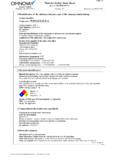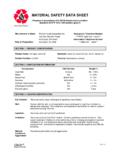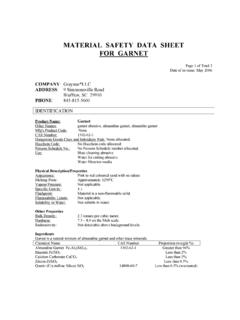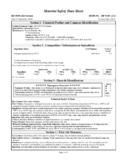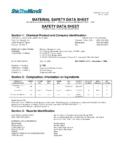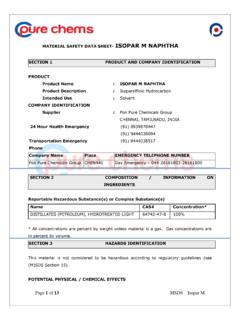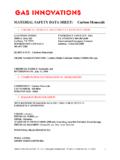Transcription of Material Safety Data Sheet - Central States Bus …
1 Material Safety data Sheet SECTION 1 PRODUCT AND COMPANY IDENTIFICATION Cat ELC (Extended Life Coolant) Premix 50/50 with Embitterment Product Use: Antifreeze/Coolant Product Number(s): CPS226387 Company Identification Chevron Products Company a division of Chevron Inc. 6001 Bollinger Canyon Road San Ramon, CA 94583 United States of America Transportation Emergency Response CHEMTREC: (800) 424-9300 or (703) 527-3887 Health Emergency Chevron Emergency Information Center: Located in the USA. International collect calls accepted. (800) 231-0623 or (510) 231-0623 Product Information email : Product Information: 800-LUBE-TEK MSDS Requests: 800-414-6737 SECTION 2 COMPOSITION/ INFORMATION ON INGREDIENTS COMPONENTS CAS NUMBER AMOUNT Ethylene Glycol 107-21-1 40 - 50 %weight Diethylene glycol 111-46-6 1 - 5 %weight Sodium 2-ethylhexanoate 19766-89-3 1 - 5 %weight SECTION 3 HAZARDS IDENTIFICATION ** EMERGENCY OVERVIEW - HARMFUL OR FATAL IF SWALLOWED - CONTAINS Material THAT MAY CAUSE ADVERSE REPRODUCTIVE EFFECTS BASED ON ANIMAL data - POSSIBLE BIRTH DEFECT HAZARD - CONTAINS Material THAT MAY CAUSE BIRTH DEFECTS BASED ON ANIMAL data - CAUSES DAMAGE TO: - KIDNEY _____ Revision Number: 8 1 of 7 Cat ELC (Extended Life Coolant) Revision Date: February 15, 2010 Premix 50/50 with Embitterment MSDS.
2 10674 ** IMMEDIATE HEALTH EFFECTS Eye: Not expected to cause prolonged or significant eye irritation. Skin: Contact with the skin is not expected to cause prolonged or significant irritation. Not expected to be harmful to internal organs if absorbed through the skin. Ingestion: Toxic; may be harmful or fatal if swallowed. Inhalation: The vapor or fumes from this Material may cause respiratory irritation. Symptoms of respiratory irritation may include coughing and difficulty breathing. Breathing this Material at concentrations above the recommended exposure limits may cause Central nervous system effects. Central nervous system effects may include headache, dizziness, nausea, vomiting, weakness, loss of coordination, blurred vision, drowsiness, confusion, or disorientation. At extreme exposures, Central nervous system effects may include respiratory depression, tremors or convulsions, loss of consciousness, coma or death.
3 DELAYED OR OTHER HEALTH EFFECTS: Reproduction and Birth Defects: Contains Material that may cause adverse reproductive effects if swallowed based on animal Material that may cause birth defects based on animal data . Target Organs: Contains Material that causes damage to the following organ(s) if swallowed: Kidney See Section 11 for additional information. Risk depends on duration and level of exposure. SECTION 4 FIRST AID MEASURES Eye: No specific first aid measures are required. As a precaution, remove contact lenses, if worn, and flush eyes with water. Skin: No specific first aid measures are required. As a precaution, remove clothing and shoes if contaminated. To remove the Material from skin, use soap and water. Discard contaminated clothing and shoes or thoroughly clean before reuse. Ingestion: If swallowed, get immediate medical attention.
4 Do not induce vomiting. Never give anything by mouth to an unconscious person. Inhalation: Move the exposed person to fresh air. If not breathing, give artificial respiration. If breathing is difficult, give oxygen. Get medical attention if breathing difficulties continue. Move the exposed person to fresh air. If not breathing, give artificial respiration. If breathing is difficult, give oxygen. Get medical attention if breathing difficulties continue or if any other symptoms develop. SECTION 5 FIRE FIGHTING MEASURES FIRE CLASSIFICATION: OSHA Classification (29 CFR ): Not classified by OSHA as flammable or combustible. NFPA RATINGS: Health: 2 Flammability: 1 Reactivity: 0 FLAMMABLE PROPERTIES: Flashpoint: Not Applicable Autoignition: No data available Flammability (Explosive) Limits (% by volume in air): Lower: Not Applicable Upper: Not Applicable EXTINGUISHING MEDIA: Use water fog, foam, dry chemical or carbon dioxide (CO2) to extinguish flames.
5 Dry Chemical, CO2, AFFF Foam or alcohol resistant foam. PROTECTION OF FIRE FIGHTERS: Fire Fighting Instructions: This Material will burn although it is not easily ignited. For fires involving this _____ Revision Number: 8 2 of 7 Cat ELC (Extended Life Coolant) Revision Date: February 15, 2010 Premix 50/50 with Embitterment MSDS : 10674 Material , do not enter any enclosed or confined fire space without proper protective equipment, including self-contained breathing apparatus. Combustion Products: Highly dependent on combustion conditions. A complex mixture of airborne solids, liquids, and gases including carbon monoxide, carbon dioxide, and unidentified organic compounds will be evolved when this Material undergoes combustion. SECTION 6 ACCIDENTAL RELEASE MEASURES Protective Measures: Eliminate all sources of ignition in vicinity of spilled Material .
6 Spill Management: Stop the source of the release if you can do it without risk. Contain release to prevent further contamination of soil, surface water or groundwater. Clean up spill as soon as possible, observing precautions in Exposure Controls/Personal Protection. Use appropriate techniques such as applying non-combustible absorbent materials or pumping. Where feasible and appropriate, remove contaminated soil. Place contaminated materials in disposable containers and dispose of in a manner consistent with applicable regulations. Reporting: Report spills to local authorities and/or the Coast Guard's National Response Center at (800) 424-8802 as appropriate or required. SECTION 7 HANDLING AND STORAGE Precautionary Measures: Do not get in eyes, on skin, or on clothing. Do not breathe vapor or fumes. Wash thoroughly after handling.
7 General Handling Information: Do not taste or swallow antifreeze or solution. Keep out of the reach of children and animals. General Storage Information: Do not store in open or unlabeled containers. Container Warnings: Container is not designed to contain pressure. Do not use pressure to empty container or it may rupture with explosive force. Empty containers retain product residue (solid, liquid, and/or vapor) and can be dangerous. Do not pressurize, cut, weld, braze, solder, drill, grind, or expose such containers to heat, flame, sparks, static electricity, or other sources of ignition. They may explode and cause injury or death. Empty containers should be completely drained, properly closed, and promptly returned to a drum reconditioner or disposed of properly. SECTION 8 EXPOSURE CONTROLS/PERSONAL PROTECTION GENERAL CONSIDERATIONS: Consider the potential hazards of this Material (see Section 3), applicable exposure limits, job activities, and other substances in the work place when designing engineering controls and selecting personal protective equipment.
8 If engineering controls or work practices are not adequate to prevent exposure to harmful levels of this Material , the personal protective equipment listed below is recommended. The user should read and understand all instructions and limitations supplied with the equipment since protection is usually provided for a limited time or under certain circumstances. ENGINEERING CONTROLS: Use process enclosures, local exhaust ventilation, or other engineering controls to control airborne levels below the recommended exposure limits. PERSONAL PROTECTIVE EQUIPMENT Eye/Face Protection: No special eye protection is normally required. Where splashing is possible, wear Safety glasses with side shields as a good Safety practice. _____ Revision Number: 8 3 of 7 Cat ELC (Extended Life Coolant) Skin Protection: No special protective clothing is normally required.
9 Where splashing is possible, select protective clothing depending on operations conducted, physical requirements and other substances in the workplace. Suggested materials for protective gloves include: Natural rubber, Neoprene, Nitrile Rubber, Polyvinyl Chloride (PVC or Vinyl). Revision Date: February 15, 2010 Premix 50/50 with Embitterment MSDS : 10674 Respiratory Protection: Determine if airborne concentrations are below the recommended occupational exposure limits for jurisdiction of use. If airborne concentrations are above the acceptable limits, wear an approved respirator that provides adequate protection from this Material , such as: Air-Purifying Respirator for Organic Vapors, Dusts and Mists. Use a positive pressure air-supplying respirator in circumstances where air-purifying respirators may not provide adequate protection.
10 Occupational Exposure Limits: Component Agency TWA STEL Ceiling Notation Ethylene Glycol ACGIH -- -- 100 mg/m3 -- Consult local authorities for appropriate values. SECTION 9 PHYSICAL AND CHEMICAL PROPERTIES Attention: the data below are typical values and do not constitute a specification. Color: Red Physical State: Liquid Odor: Faint or Mild pH: - Vapor Pressure: mmHg (Typical) @ 20 C (68 F) Vapor Density (Air = 1): Boiling Point: C (228 F) Solubility: Miscible Freezing Point: C (-34 F) Specific Gravity: @ C ( F) / C ( F) Viscosity: No data available SECTION 10 STABILITY AND REACTIVITY Chemical Stability: This Material is considered stable under normal ambient and anticipated storage and handling conditions of temperature and pressure.

